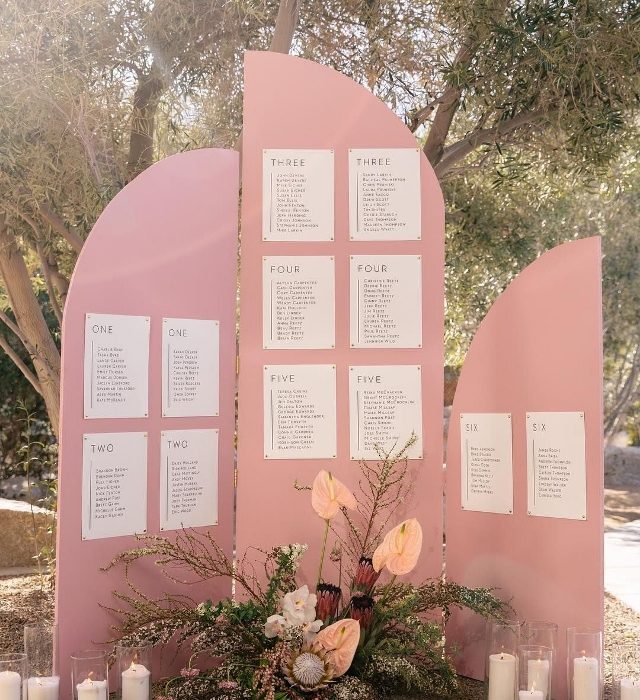It can be fun to start putting together the guestlist for your wedding, but you might quickly realize that the process can be trickier than you initially thought. While some couples will want to invite everyone they possibly can, with budget and venue size in play, it often just isn’t possible. It can be difficult—and sometimes a bit awkward—deciding who you are going to invite, but there are a few steps you can follow to make the process pain-free.
Start with the Venue
Before even starting on your guest list, it might be smart to establish your venue beforehand.
You’ll probably have an idea if you are veering more towards a huge bash or an intimate celebration, so let that guide you when thinking of which venues to look at. If you aren’t totally sure on how many guests you are looking to invite, make a first draft version of your guest list to help you get a general idea.
Once you have a venue, establish the minimum and maximum guest numbers of your event space, as well as your budget. Factors like food and plates prepared, wedding favors, cake, chair, and table rentals, and more are all influenced by guest numbers—and of course, the higher the numbers, the higher the cost.
Splitting the List with Parents
Once you have your guest numbers set, you need to determine how you will split the guest list with both sets of parents. This may vary based on who is financially responsible for the wedding. A common and straightforward way is to split it into thirds: a third for the bride and groom, a third for the bride’s parents, and a third for the groom’s parents. Another way is to give half the list to the bride and groom, and the remaining quarters to the sets of parents.
After telling everyone the max that they can invite, you may want to set certain rules so that they don’t end up inviting someone just so they can fill up their count. For example, you may want to set a guideline that they can’t invite a friend that neither the bride or groom has met. Let them know that they don’t need to invite the max number—any extra spots can be allocated to the bride and groom or other set of parents.
Drafting Your List
It can be a bit overwhelming to start a guest list, but you can break up the potential guests into groups to make the process a bit easier. Some of the most common groups include:
- Immediate and Distant Family: Of course, it is a no-brainer to invite your immediate family. When it comes to aunts, uncles, cousins, and more distant relatives, you’ll need to look at your own family dynamic to decide. Keep in mind that just because one side is inviting distant relatives, it doesn’t mean the other side needs to as well. Some families are closer, while others are less tight-knit, so don’t feel the need to invite an equal number of family members.
- Friends: The next obvious choice on the list is your friends. Start with your closest friends, and then work outwards from there. Keep in mind neighbor friends, college or high school friends, and any other friends who you speak to on a regular basis.
- Co-workers: It can be tricky to decide if you want to invite your co-workers and boss. A good rule of thumb is to either invite everyone in your department, or no one at all. This is especially true of small office environments. That being said, just like with family members, an office dynamic can vary, so invite whichever combination of co-workers makes sense to you.
- Plus Ones: Plus ones can make a huge dent in the guest count. If you are allowing plus ones to every adult, the guest list numbers can rise drastically. You may need to give out plus ones a bit sparingly in order to maintain the numbers. If you are giving out plus ones to some people and not others, it is a good idea to make a hard rule and stick to it. This may mean no plus ones for those who have been dating for less than 6 months, or only plus ones for those who are engaged or married.
- Children: It is a good idea to discuss if you’ll be inviting children to the wedding early on. While children can add to the list, keep in mind that, if you decide not to invite children, certain guests may not be able to attend. If you decide to leave children out of the celebration, make sure this is clear on the invitation.
The most important guests on the list: the bride and the groom! You will need to count yourselves, especially when it comes to catering numbers, so make sure you jot down your names as well.
Narrowing Down and Creating the Final List
If your first guest list draft exceeds your maximum budget and/or venue numbers, you’ll need to make some cuts. Of course, this can be a difficult process, but there are a few rules you can follow to make the cuts a bit easier. These rules could be:
- Taking children off the list and only inviting the parents.
- Cutting off people you haven’t spoken to in recent years, or the friends that your parents aren’t as close to.
- Being stricter with your plus one rule. If you initially gave all adults a plus one, you may want to implement some of the guidelines mentioned above.
Don’t think that you need to completely abandon some of the guests you’ve cut from your initial list. Many couples choose to make a secondary list to pull from when guests from the initial list aren’t able to attend.
While it’s unlikely that every invited guest will be able to attend (you can expect a “no” response from around 10% of your guests), save yourself some stress and don’t go over the maximum number of invited guests. Make sure this number includes the potential of everyone who was given a plus one bringing a date.
Dealing with RSVPs
Once you’ve finalized your guest list (and potentially your secondary list), you can start sending out your save the dates and eventually your wedding invitations. To save yourself some stress, keep a spreadsheet of all the responses you get as you get them, including plus ones. This will help you keep track of everything, and give you a clear idea of the final counts for catering, chair and table rentals, and more. This is especially important for those who will be inviting from the secondary list.
If you are in the process of planning your wedding, come to the next Georgia Bridal Show near you. You will have the chance to meet with wedding professionals from Georgia and the Southeast who can help bring your vision to life!
Georgia wedding vendors, as well as other wedding professionals across the Southeast, can contact us about opportunities for exhibition and online marketing with Georgia Bridal Show.


